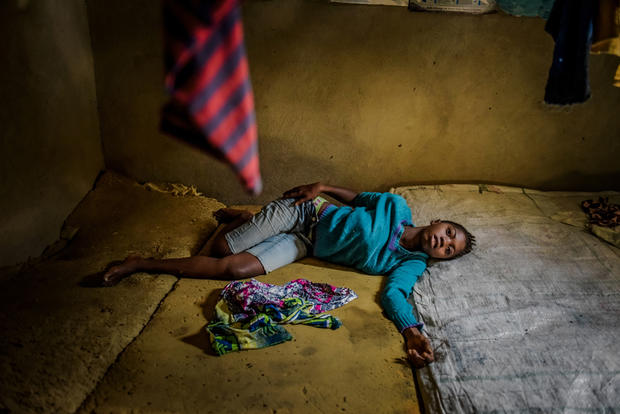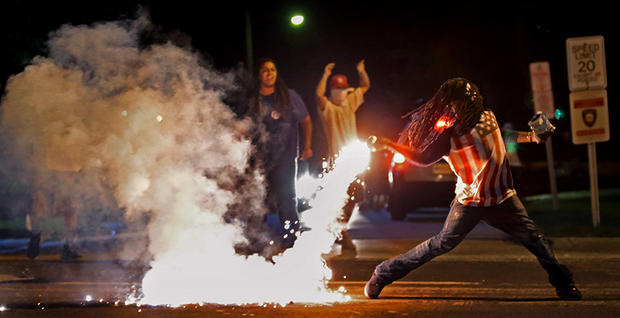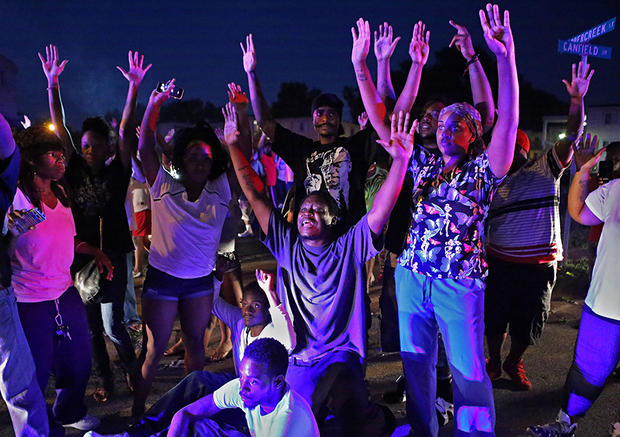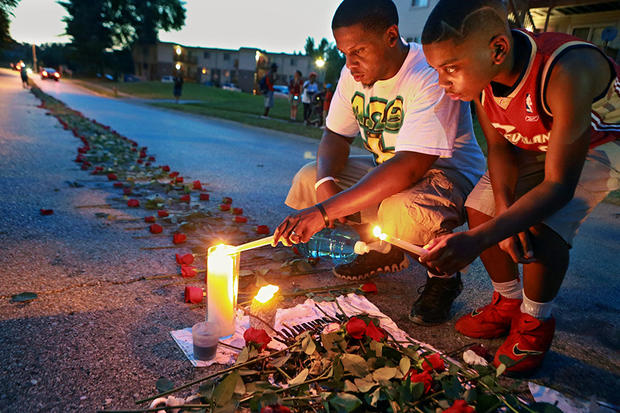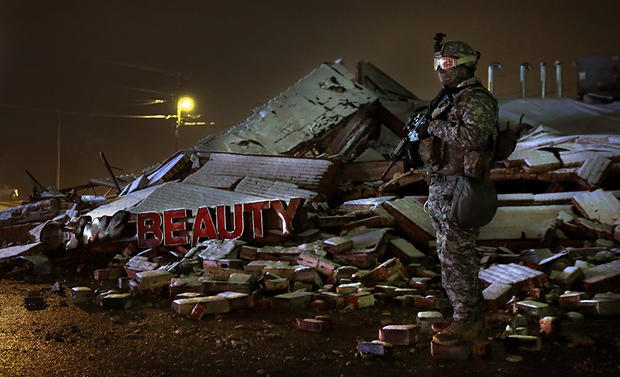2015 Pulitzer winners for photography
Photographer Daniel Berehulak's coverage of the Ebola crisis for the New York Times in Africa and the photography staff of the St. Louis Post-Dispatch's photos of the aftermath of the death of Michael Brown in Ferguson, Missouri were awarded the 2015 Pulitzer Prize for Feature Photography and Breaking News Photography respectively, April 20, 2015.
The Pulitzer Prize is the highest award in newspaper and online journalism awarded each year in twenty-one categories.
Ebola, Daniel Berehulak:
Eric Gweah, 25, weeps as a burial team removes the body of his 62-year-old father, who died at home, arms thrashing and blood spewing from his mouth, in front of his sons after being turned away at the treatment centers in Monrovia, Liberia, September 18, 2014.
"The only thing the government can do is come for bodies -- they are killing us," Gweah said.
Ebola crisis
Residents call attention to a man lying dead on a busy street in Monrovia, Liberia, September 15, 2014.
They said the man had died three days earlier. The family had been calling to have the body removed from home, but when no burial team came, people wearing rubber gloves dragged it into the street, stopping traffic and demanding that it be taken away.
Berehulak spent four long months chronicling the scourge of Ebola as it spread across West Africa for The New York Times.
Ebola crisis
A man with Ebola symptoms waits to be admitted outside the Doctors Without Borders treatment center in Monrovia, September 4, 2014.
At the height of the epidemic, many people could not gain admission to such centers and died at home -- or in front of the treatment centers.
Ebola crisis
Residents of the West Point slum in Monrovia complain about the lack of necessities to a government official after the neighborhood was quarantined, a closure that set off deadly riots, August 25, 2014.
Daniel Berehulak documented the chaotic period before the epidemic drew the world's attention.
Ebola crisis
James Dorbor, 8, suspected of being infected with Ebola, is carried by medical staff to an Ebola treatment center in Monrovia, September 5, 2014. The boy, who was brought in by his father, lay outside the center for at least six hours before being seen.
Ebola crisis
Etienne Ouamouno, father of the baby thought to be Patient Zero in this Ebola epidemic, in the village of Meliandou, Guinea, December 14, 2014.
Ebola crisis
Health workers putting in long hours, at sunset, in the high-risk wards at the Bong County Ebola Treatment Unit in Suakoko, Liberia, October 6, 2014.
Ebola crisis
A burial team transfers Mama Flomo, a 37-year-old mother of three who died before she reached a center that would treat her, to her grave adjacent to the Bong County unit, October 5, 2014. She died while giving birth prematurely.
Ebola crisis
A girl nicknamed Sweetie Sweetie, who lost both parents to Ebola and is thought to be 4 years old, at a care center in Port Loco, Sierra Leone, December 6, 2014.
Ebola crisis
Health workers pray before the start of their shift at the Bong County treatment center, October 6, 2014.
Ebola crisis
A Liberian Red Cross team removes the body of a 30-year-old woman thought to have died of Ebola in Monrovia, September 18, 2014.
"We came here for the husband last week, we're back today for the wife, and maybe next week we'll be back for the children," a team member said.
Ebola crisis
Isatu Sesay, 16 years old, delirious and in pain, three hours before her death in Freetown, Sierra Leone, November 21, 2014.
Dozens of calls for an ambulance over three days had failed.
Ebola crisis
A relative grieves as a Liberian Red Cross burial team dresses in protective clothing before removing the body of a suspected Ebola victim in central Monrovia, September 18, 2014.
The team had gone to the compound four times in the past four weeks. The family of the dead man, sick for six days with the hemorrhagic fever's telltale symptoms, had taken him twice by taxi to treatment centers, only to be turned back for lack of beds.
Ebola crisis
Body collectors from the Liberian Red Cross remove a suspected Ebola victim from a home in Monrovia, September 17, 2014
Ebola crisis
Workers entering the high-risk zone of the Bong County treatment center in Liberia, October 6, 2014.
Ebola crisis
An Ebola survivor, George Beyan, walks his 5-year-old son, William, who tested positive for Ebola, at the Bong County treatment center. Cured, George was free to go home, October 19, 2014. But the staff told him that, now immune, he would be the best person to look after his son. William died a few days later.
Ebola crisis
Esther Doryen, 5 years old, is carried to an ambulance in Monrovia, August 31, 2014. She died a week later.
Ebola crisis
People with Ebola symptoms, or who have family members showing such symptoms, wait to be admitted at the JFK Ebola treatment center in Monrovia, September 5, 2014. For the victim at far right, it was too late.
Ebola crisis
Joseph Gbembo leans over the grave of his mother, Sia, at the cemetery in Foya, Liberia, where four members of the family who died in the epidemic now lie, December 16, 2014
The Michael Brown story - Ferguson
The staff of the St. Louis Post-Dispatch won the 2015 Pulitzer Prize for Breaking News Photography for their coverage of the story of the death of unarmed 18-year-old African-American Michael Brown, who was shot and killed by white police officer Darren Wilson from Day 1 through the November 2014 grand jury decision not to indict Wilson.
Edward Crawford returns a tear gas canister fired by police who were trying to disperse protesters in Ferguson, Missouri, August 13, 2014. Four days earlier, unarmed black teenager Michael Brown was shot to death by white police officer Darren Wilson.
The killing ignited riots and unrest in the St. Louis area and across the nation.
The Michael Brown story - Ferguson
Lesley McSpadden is comforted by her husband, Louis Head, hours after the fatal police shooting of her son Michael Brown in the Canfield Green Apartments in Ferguson, Missouri, August 9, 2014.
The St. Louis Post-Dispatch photography staff was recognized for "powerful images of of the despair and anger in Ferguson, Missouri, stunning photojournalism that served the community while informing the country," according to the judges for the 2015 Pulitzers.
The Michael Brown story - Ferguson
Lesley McSpadden drops rose petals onto the blood-stained street in Ferguson where her son's body was left for more than four hours after he was killed by a police officer, August 9, 2014.
The Michael Brown story - Ferguson
"All of my friends have been killed! I'm sick of it," yelled protester Jamell Spann at police officers dressed in riot gear who cleared hundreds of demonstrators to prevent them from surrounding the Ferguson Police Department, August 11, 2014
The Michael Brown story - Ferguson
"Don't shoot us!," yell residents taunting police officers who were arriving to break up an angry crowd on Canfield Drive in Ferguson, hours after an officer killed Michael Brown, August 9, 2014.
Rumors state that Michael Brown had his hands up when he was shot by officer Darren Wilson. The night was the genesis of the "Hand up, don't shoot!" movement that spread across the country.
The Michael Brown story - Ferguson
A looter armed with a gun in his waistband steals items from a QuikTrip after riots broke out at the end of a candlelight vigil for Michael Brown, August 10, 2014. The store was later set afire.
The Michael Brown story - Ferguson
The emotional toll of a week of protesting appears on the face of a St. Louis County police officer as marchers yell profanity at the officers on West Florissant Avenue in Ferguson, August 17, 2014.
The Michael Brown story - Ferguson
A member of the St. Louis County Police tactical team fires tear gas into a crowd of people in response to a series of gunshots fired at police during demonstrations in Ferguson, August 18, 2014.
For more than two weeks, police and protesters clashed nightly.
The Michael Brown story - Ferguson
A protester shields himself from exploding tear gas canisters, August 13, 2014. On this night protesters attempted to throw Molotov cocktails, rocks and bottles at police.
It was the fourth consecutive night police used tear gas to disperse the crowd.
The Michael Brown story - Ferguson
Helped by a stranger, Cassandra Roberts has tear gas cleared from her eyes as she sits outside a McDonald's, August 17, 2014. "We thought it could be a peaceful night," said Roberts, who was marching in Ferguson for the first time. "What the hell is going on in this world?"
The Michael Brown story - Ferguson
Roses stretch more than 60 yards through the Canfield Green Apartments to the Michael Brown memorial as Theo Murphy and his brother Jordan Marshall light candles, August 21, 2014.
The Michael Brown story - Ferguson
The casket of Michael Brown exits Friendly Temple Missionary Baptist Church at the end of his St. Louis funeral, August 25, 2014.
Thousands of mourners filled the church and lined the streets for Brown's farewell.
The Michael Brown story - Ferguson
Michael Brown, Sr. wipes fingerprints from the vault containing the casket of his son before it was lowered into the ground at St. Peter's Cemetery, August 25, 2014.
The Michael Brown story - Ferguson
Asher Kolieboi operates a puppet of Michael Brown as thousands of people march against police violence in downtown St. Louis during a weekend series of demonstrations called 'Ferguson October', October 11, 2014.
The Michael Brown story - Ferguson
Joshua Williams (center) and Nicholas Austin Jackson shout at St. Louis Police Chief Sam Dotson as he attempts to speak at a meeting of the Ferguson Commission, a special advisory board appointed by Missouri Gov. Jay Nixon to recommend governing solutions, December 8, 2014.
Some in the crowd stood and turned their back on Dotson as he spoke, others heckled him.
The Michael Brown story - Ferguson
Ferguson protester Cheyenne Green struggles to hold onto an American flag as a football fan makes a grab for it outside the Edward Jones Dome after a St. Louis Rams game, October 19, 2014.
The Michael Brown story - Ferguson
A driver grabs a gun while keeping an eye on protesters who broke out the rear window of his minivan. Moments earlier, the man had struck several protesters who had come from Ferguson to protest in St. Louis. They were blocking an intersection and climbed onto the hood of his car when they were flung off as he drove away, December 3, 2014. The demonstrators then chased him and surrounded his vehicle, at which point the driver pulled out the gun. Police later arrested the man.
The Michael Brown story - Ferguson
Protesters take pictures in front of Juanita's Fashion R Boutique on West Florissant Avenue in Ferguson, hours after a grand jury declined to indict police officer Darren Wilson in the shooting death of Michael Brown, November 14, 2014.
Twelve businesses along a stretch of roadway more than a mile long were burned to the ground.
The Michael Brown story - Ferguson
A Missouri National Guardsman stands over the rubble of Prime Beauty Supply in Ferguson, November 26 2014.
Though Gov. Jay Nixon had activated the guardsmen several days before the grand jury's verdict was announced, they were kept out of Ferguson until the following day.











